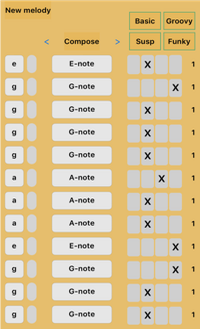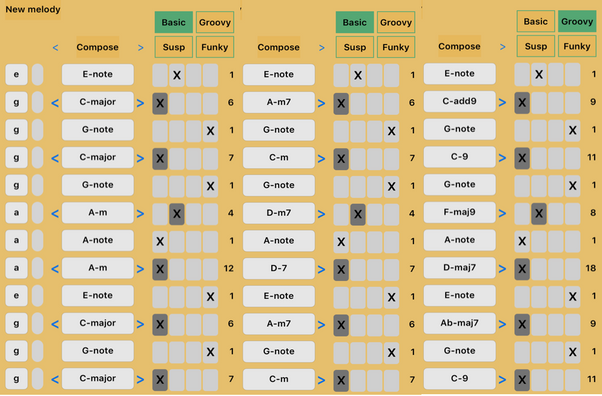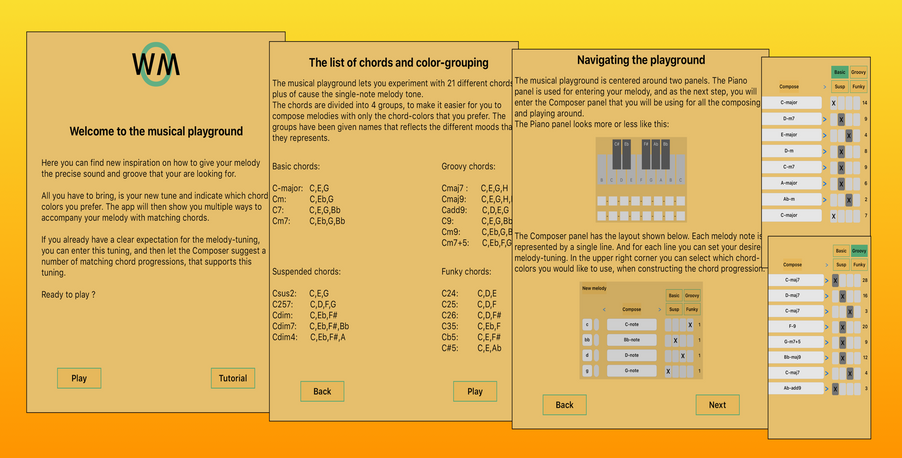
Ways of Music
Finally, it’s here. It has been a long time on its way, but as of august 2017, this new app is available on Apple App Store. This App is all about composing your own music, and understanding how to get exactly the sound and groove that you as a musician are looking for.
It can also be used for guidance in constructing usable training exercises containing 20+ different chord types, input to ear-training, improvisation suggestions etc.
But most importantly, this App will show you the importance of choosing the right combination of chords, in order to get the desired tuning of your melody.
Experiment with it. Make you own melodies. Have fun with it. And if you are not already playing an instrument, start now. It’s never too late. And this App will help you getting up to speed and be you travel guide on the Ways of Music.
Enjoy.
The Power of Music = 74
Really? Year, really! And then some.
Ever wondered if the last original song has soon been written, and from then on, every new composition is just at repetition of past geniuses. And whether music generating robots in a near future, almost by change, will play Mozart and Beatles.
Let’s say, just for the sake of the argument, that there is an App, that knows 22 different chord-types, and offers a way of showing how these chords is perceived by the listener.
If we then asked this App to help us visualize the possible number of variations - chord progressions - for a very simple tune, with just 4 notes, what would the result look like?
Here is what it would look like.
The left side of the illustration shows the famous progression I - V - vi - IV, and the numbers indicates, if we are just using the basic major, minor and 7’s chords, how many variations that exists for each note. And if you have previously experimented with this App, you would know that the “x” markings forces a specific melody tuning that corresponds with the D-A-Bm-G progression.
Now look at the image in the center, how large these numbers gets, when we expand the list of available chords to all 22 possible types. And still keeping the tuning pattern locked to the original I-V-vi-IV sound.
Now let’s say that we where not particularly picky about the melody tuning, and just wanted to know how many different progressions exists for the 4 melody-notes, d - a - h - g.
74 x 74 x 74 x 74 = 30 million combinations.
With only 4 melody notes !
Fortunately, the mentioned App do exist. So don’t loose your way. Download the App, enter your melody, select you melody-tuning, and press the compose button. The App will offer you suggestions. But it still needs a musicians touch.
The rest is up to you.
You don’t really care for music
Or do you?
Then maybe you’ve also heard about a secret chord. And are still looking for it.
You already know about the major, the minor, the fourth and the fifth. And sometimes these chords do the trick, and everything is fine. But then again, when you are in a certain mood, and are craving for expressing a particular, very personal and heartfelt feeling through your music, you feel bewildered, raise your head to the sky and hope for divine inspiration.
But there is an easier way.
Each variation of your moods, feelings and temperament can be expressed through the right combination of melody-notes, melody-tuning and chords.
To understand this, look at the example shown below, that composes elaborate musical sensations, starting off from the first 12 melody-notes of a very famous melody.
The first thing to notice is that the melody by itself - without the chord-harmonies - is trivial and almost boring. In the second image, the most commonly used chords have been added to the melody. Now this is where our exploratory journey already starts to get interesting, and we get our first epiphany. Notice how the 12 melody-notes + the added chords completely changes the melody-tuning (the position of the “X” markings). This is the core explanation of why the chord-based version, almost magically, sounds a lot more intriguing than the single-note version.
It is the rapid shift in melody-tuning, from column 1 to 4 to 1 etc. that completely revitalizes the core melody!


Now that we have a melody with exactly the vibe and the flow that we recognize from the many times we’ve heard this tune before, we are ready to experiment. And we need to experiment, because we are looking for these secret chords, remember. The chords that can express our precise mood and temperament.
The rest of the illustrations below gives a few examples on chord-progressions that can give the tune different groovy and funky moods. And as you can see, it is even possible to replace every note with a chord, while still keeping the tuning in place.
You can experiment like this, without compromising the original tune - as long as you are sticking to the melody-notes and the melody-tuning of the original tune.
Now here comes the real secret.
As long as you keep the original tuning, the sensation will not change all that much. But if you alter the tuning, new dimensions of the musical universe will open up to you. But the more you move into these other dimensions, the farther you will wander away from the track of the original tune.
But maybe you’ll need to go there, to find the very special music resonance that your heart is searching for.
This is the soul of the Ways of Music.
Hallelujah !
Read
Learn
Experiment
Improvise
Teach
Enter your melody, and tuning variations, and let the Composer list a number of chord-progressions that fits you request
Compose your own variations of Piano runs
Guitar licks
Bass lines
Fillers
Vamps
Pentatonic scale
Blues scale
Jazz scale

